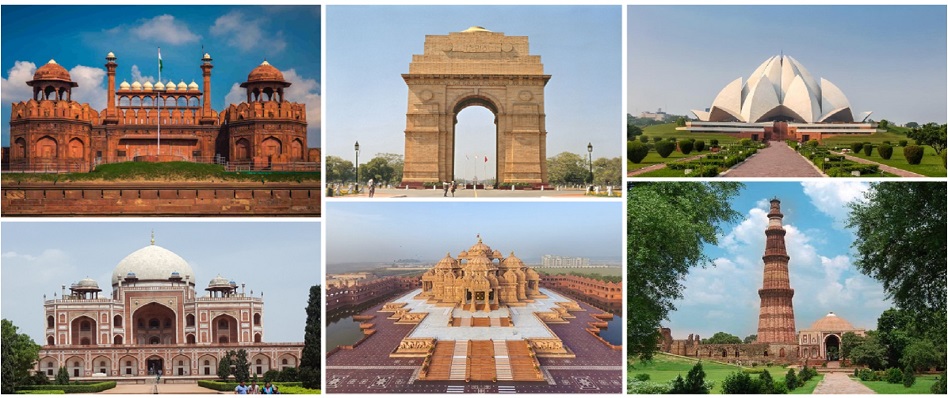
Dear Travellers and explorers seeking out “The Taj Mahal”, Agra – Delhi Tour, Which is the best and superlative choice for exploring the extraordinary richness of Indian culture and art. You can plan a Delhi to Agra tour Package by hiring our Cabs & enjoy the Delhi Agra Tour. In this unique tour, we will introduce you to the Agra & Delhi nearby tourist places.
DAY 1 : AGRA SIGHTSEEING
TAJ MAHAL
Amongst The Seven Wonders Of World, Taj Mahal Was Built By Mughal Emperor Shah Jahan In The Loving Memory Of His Beloved Wife Mumtaz Mahal. The Great Monument Took 22 Years For Completion I.E. From 1631 to 1653 AD. Explore The Gripping And Spell Binding Beauty Of Taj Mahal.
AGRA FORT
After Mouth Watering Lunch, Enjoy The Magnificent Beauty Of Red Sandstone Agra Fort, AgraPositioned On The Banks Of River Yamuna. It Was Built In The Year 1565 By Akbar The Great.
TOMB OF ITIMAD-UD-DAULAH
Often referred to as the "Baby Taj Mahal", the tomb of Itimad-ud-daulah is a Mughal mausoleum and often regarded as a copy of the Taj Mahal. This is the first tomb in India made entirely of marble. The tomb was commissioned by Nur Jahan, the wife of Jahangir, for her father Mir Gheyas Beg (later known as Itimad-ud-daulah), who was a minister in the court of Shah Jahan.
VISIT MEHTAB BAGH SUNSET POINT - BACK VIEW OF TAJ MAHAL
This is an optional site to visit, if you are in hurry you can skip it. Exploring the back side of a Taj Mahal. Here you will see the magnificent reflection of Taj Mahal over the river Yamuna during the time of sunset.
AKBAR TOMB(SIKANDRA)
There is no denying fact that Agra is a paradise of the Mughal’s timeless monuments. The suburb of Agra, Sikandra, is renowned for the tomb of “The Great Akbar”. The place Sikandra is named after the second ruler of the Lodi Dynasty, Sikandra Lodi. It was used to be the resting place of the Mughal ruler, Akbar. It is estimated that the tomb built in the 17th century covers the area of approximate 119 acres. It is said that mausoleum was chosen by him but could not complete it during his occupancy.
GURUDWARA GURU KA TAAL
After lunch you will be taken to Agra Fort, constructed by Mughal Emperor Akabar in 1565 A.D. It is home to many other buildings named Moti Masjid and Musanman Burj, where Shah Jahan is believed to have taken his last breath as he had been imprisoned there. Like Taj Mahal Agra Fort is also located near the bank of river Yamuna. It was made by the famous Mughal Emperor Akbar in about 1565 A.D. The grand walls of Agra fort were made by sandstone. You will find that there are only four gates in the fort. There are some of the most famous places in the fort that are Khas Mahal, Sheesh Mahal and the Masjid (mosque).
LOCAL MARKET
Enjoy Visit To Colorful Arts And Handicraft During The Delhi Agra Tour !
FATEHPUR SIKARI
Enjoy a delicious lunch in Multi Cousin Restaurant. After Lunch Visit Fatehpur Sikri, the magnificent fortified ancient city 40 kilometers west of Agra, and the short-lived capital of the Mughal empire between 1572 and 1585, during the reign of Emperor Akbar. Earlier, Akbar had visited the village of Sikri to consult the Sufi Saint Shaikh Salim Chishti, who predicted the birth of a heir to the Mughal throne.
DAY 2 : DELHI SIGHTSEEING
Qutub Minar
The origins of Qutab Minar are shrouded in controversy. Some believe it was erected as a tower of victory to signify the beginning of the Muslim rule in India. Others say it served as a minaret to the muezzins to call the faithful to prayer. No one can, however, dispute that the tower is not only one of the finest monuments in India, but also in the world.
Red Fort
So called because of the red stone with which it is built, the Red Fort is one of the most magnificent palaces in the world. India's history is also closely linked with this fort. It was frorth here ht the British deposed the last Mughal ruler, Bhadur Shah Zafar, marking the end of the three century long Mughal rule. It was also fromits ramparts that the first prime. Minister of India, pandit Jawharlal Nehru, announced to the nation that India was free form colonial rule.
Humayun's Tomb
The mughals brought with them a love for gardens, fountains and water. The first mature example of Mughal architecture in India, Humayun's Tomb was built by the emperor's grieving widow, Haji Begum, in 1565 AD. Constructed with red sandstone and ornamented marks the beginning of a new tradition of ornate style which culminated in the Taj Mahal of Agra.
Jantar Mantar
At first sight, the Jantar Mantar appears like a gallery of modern art. It is, however, an observatory. Sawai Jia Singh II of Jaipur (1699-1743), a keen astronomer and a noble in the Mughal court, was dissatisfied by the errors of brass and metal astronomical instruments.Under patronage from the emperor, he set on himself the task of correcting the existing astronomical tables and updating the almanac with more reliable instruments. Delhi's Jantar Mantar is the first of the five observatories that he built with large masonary instruments.
Jama Masjid
Work on the Jama Masjid mosque was begun in 1650 by the Mughal Emperor Shah Jahan to complement his palace at the Red Fort.
India Gate
Built as a memorial to commemorate the 70,000 India soldiers killed in World War I, India Gate was designed by Sir Edwin Lutyens and completed in 1931. Located on Rajpath, the road which leads to the magnificent Rashtrapati Bhawan, the gate is 160 feet high with an arch of 138 feet.
Raj Ghat
The mortal remains of Mahatma Gandhi were cremated on this spot on the west bank of the river Yamuna on the evening of January 31, 1948. A simple open platform inscribed with the Mahatma's last words, 'Hey Ram' (Oh God) is set in a garden with fountains and a variety of exotic trees.
Departure Railway Station
Now Get Ready For Drive Back To Railway Station For Journey Back Home As Your .
Enquiry Now for Best Deals

